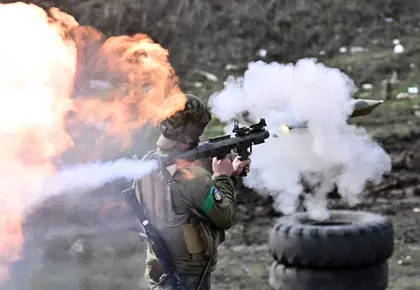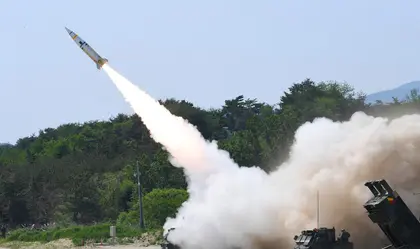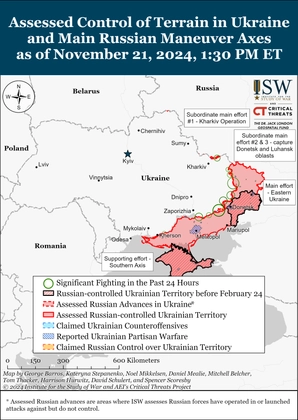Ukraine’s long-awaited spring offensive actually has begun, and if you look closely enough, you can see not just the predictable smoke and explosions, but anti-Kremlin head games in progress too, military observers said.
By most accounts, a shock force of 10 to 15 Armed Forces of Ukraine (AFU) brigades, or between 15,000 to 30,000 soldiers, has either been recently pulled off the fighting line, is resting and recuperating, or is finishing up training at bases in NATO states, and preparing to take part in the biggest-ever massed attack attempted by the Ukrainian army. The ground assault’s exact timing and location are closely guarded military secrets, and the pre-attack artillery bombardment hasn’t begun.
However, Ukraine’s military leadership is already moving to win the psychological battle prior to that attack, and even though a significant part of the AFU is now in training, increasing numbers of Ukrainian precision-guided rockets, ballistic missiles and kamikaze drones are flying deep into Russian-held territory in the direct path of the probable offensive and blowing things up, Ukrainian military analyst Oleksiy Hetman told Kyiv Post in an interview.
“This will be a complex offensive, using all facets of military pressure, not just with conventional weapons on the battle line, but with attacks in the information spectrum, partisans, and deep strikes,” Hetman said. “The Ukrainian military will work to create the best possible conditions for the conventional ground offensive to be successful, and some of that you can see happening right now… Information warfare absolutely is part of that.”

‘Another Example of Reckless Behavior From Russia’ – Ukraine at War Update for Nov. 22
Oleh Izhak, senior analyst at the National Institute of Strategic Research, said that although it’s not possible to be positive, the recent leak of secret US military briefing slides on the Ukraine war and the AFU’s offensive preparations (first reported by The New York Times on Monday) was a desire by “someone” either in Washington or Kyiv to make Russian military decision-making more difficult by “leaking” information the Kremlin is already aware of, and forcing Russian President Vladimir Putin – a former secret agent with a secret agent’s paranoia about planted information - to question its validity.
“I think mostly it is an attempt to affect decision-making in Russia… I am not excluding the possibility that this is some kind of attempt at a strategic trick, by publishing information that really is already out there… It’s kind of like these constant conversations about Putin’s health,” Izhak said in an April 9 YouTube interview.
Hetman and others interviewed for this story said the AFU’s leadership is fully embarked on a multi-pronged mind games campaign against the Russian military and civilian population employing everything from loudspeaker trucks in the Kreminne sector calling on Russian troops to surrender, to blanket warnings of arrest and criminal accountability to Ukrainian officials currently living in Russia-occupied territory, to solemn ceremonies marking one-year anniversaries of the Bucha mass murders and Russian retreat from Kyiv, to granting independent media access to Russian POWs for interviews.
Kyiv is not only targeting Russian hearts and minds but, almost equally, European allies still unconvinced Russia’s forces might ever be defeated, some observers said. In the probably several weeks left between the present and when the main force of NATO-trained and -equipped Ukrainian troops are physically in their marshalling areas, a critical Kyiv objective will be to drag European doubters in Ukrainian battlefield success on board and turn that into real material support, said Florin Blanaru, a Romanian army officer (retired) and operations specialist.
“Ukraine has successfully applied complex operations of camouflage and protection of the preparations for the upcoming offensive,” Blanaru said in an interview. “The real question is whether there will be any offensive in a situation where the Ukrainian army (and people) are determined to fight till to the end… (but) external actors overtly supporting the (Ukrainian) war effort give confusing signals, particularly Hungary, France, EU leadership, (with) actions promised, but either delayed or not fulfilled.”
Senior Kyiv officials led by President Volodymyr Zelensky have said key material prerequisite for a successful offensive is en route, but not yet on the ground in Ukraine. This includes a small arsenal of NATO-standard anti-aircraft systems not yet delivered Ukraine by western states: the powerful US-made long-range Patriot missile, the Norwegian NASAMS short range missile, and the Italian-French SAMP/T medium range missile system. The first Patriot battery should be fielded, with newly trained crew, by the end of April, Ukrainian news reports said.
Ukrainian forces in the sector selected for the offensive must at minimum make airspace over their forces and above ground the AFU intends to capture - too dangerous for Russian planes and drones to fly in - and, if possible, turn the sky into a place where Ukrainian strike aircraft (increasingly attack drones and surface-to-surface missiles) can hit targets without Russian interference, observers said.
On Saturday, two massive blasts rocked the Crimean port city Feodosia, some 250 km. from the closest Ukraine-controlled territory. A flurry of local Kremlin-associated official claims followed, claiming that whatever the Ukrainians sent had been shot down by local air defense forces.
Social media, Ukrainian officials and, ultimately, Putin-appointed Crimea boss Sergei Aksenov later confirmed in fact Kyiv had most likely launched a pair of long-range surface-to-surface missiles, each with a half-ton warhead. Russian air defenses knocked down one of the ballistic weapons but the second, according to Ukrainian sources, demolished a Russian S-300 anti-aircraft missile battery.
The S-300 is one of Russia’s top-tier air defense weapons. Destruction of a Feodosia-based system, potentially, could open an air gap dozens of kilometers wide for Ukrainian drones and missiles to penetrate in future strikes against Russian forces deployed to the southern front.
Along with Russian anti-aircraft systems, observers said -and news reports confirmed - in the lead-up to the offensive the AFU has turned its sights to Russian military infrastructure in the southern sector - particularly munitions, transport hubs, and troop concentrations.
On Friday Ivan Federiv, mayor-in-exile of the Russia-occupied city Melitopol, by many accounts a primary intermediate objective for the upcoming Ukrainian attack, claimed a series of strikes launched from April 3-6 had hammered Russian troops and combat vehicles billeted in an industrial district. He did not identify the weapon used or describe exact targets. Social media video entering the public space on Tuesday and geo-linked to Melitopol’s rail station showed a spectacular nocturnal explosion setting a massive fire. Russian sources claimed multiple US-made HIMARS-launched rockets, a GPS-guided munition carrying a 90 kg. warhead, were used in the attacks and that rail infrastructure was damaged.
Since late March, based on AFU statements and local accounts, unexplained explosions, some possibly by civilian drones modified to carry explosives, have hit military targets near the villages Razdolne and Gvardeyske in Crimea, the cities Belgorod, Rostov and Kursk in south-west Russia, and the Russia-occupied Ukrainian city Mariupol.
The most spectacular attack, on March 20, pounded a rail switching yard in the Crimean city Dzhankoe - according to Ukrainian sources - devastating a train carrying Russian Kinzhal missiles, an air-launched weapon used by Kremlin forces in past months to attack Ukrainian cities and power grid infrastructure.
“The Ukrainians are getting ready,” Getman said. “You can see it happening.”
You can also highlight the text and press Ctrl + Enter






